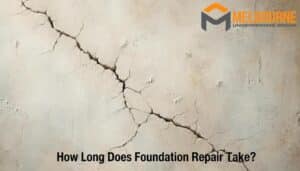
Yes, you can minimise foundation movement on your property. A few ways you can prevent the movement of your foundation are by ensuring proper drainage, monitoring the trees you plant, and addressing plumbing concerns immediately.
It is also best to get a solid foundation right from the start. Consulting with a licensed engineer and underpinning contractor before setting up a property can go a long way in minimising movement.
In this blog, we’ll talk more in-depth about preventing foundation movement and its associated issues.
How Can I Prevent Foundation Movement?
The following are the most common ways you can prevent foundation movement on your property:
Ensure Proper Drainage
It’s vital to direct water away from your property’s foundation. Install gutters and downpipes, ensuring that they channel rainwater at least 2 metres away from your home. Maintain the gradient of your garden so that water flows away from your property. This prevents the soil around your foundation from becoming excessively soaked and stops wall cracks from forming.
Monitor Trees and Plants
Large trees close to your home can extract substantial amounts of water from the soil, causing it to shrink. If planting trees, opt for species with non-invasive root systems, and place them at a safe distance from the property. Regularly prune or manage mature trees to control their water uptake and reduce potential damage to the foundation.

Address Plumbing Issues
Leaks from broken pipes or poor plumbing can introduce unwanted water into the soil around your foundation. Ensure that your plumbing system is regularly checked and promptly address any leaks. This prevents localised soil saturation which can lead to differential settlement or movement.
Opt for a Strong Foundation
If constructing a new property or extending an existing one, consider investing in a deep or reinforced foundation, especially if you’re in an area known for problematic soil. Consult with a structural engineer to determine the best foundation type, whether its pier and beam, raft, or another appropriate method for your specific site conditions.
What Are the Soil Classifications in Melbourne?
The following are the main soil classifications in Melbourne:
- A: Stable sand and rock – minimal ground movement
- S: Mildly reactive clay
- M, M-D: Moderately reactive clay or silt (shifts with moisture variation)
- H1, H1-D: Highly reactive clay
- H2, H2-D: Very highly reactive clay
- E, E-D: Extremely reactive soil
- P: Soft soil with varying fill depths (reactive due to unusual moisture or unclassifiable sites)
Is It Normal For Footings to Move?
Yes, it is normal for footings to move within expected limits. Generally, wall cracks under 1 mm are seen as standard foundation movement. Wall cracks between 1 mm and 5 mm should be watched throughout all seasons for a year.
A closer look will be necessary for homes showing notable signs your home needs foundation repairs. If your property is over a decade old, it’s best to consult your builder first.
In more serious scenarios, these cracks might need extensive repairs. Cracks over 5 mm are viewed as significant and exceed acceptable levels of movement. Shifting foundations might also lead to protruding walls, doors, or windows that jam or become misshapen.
You should get in touch with a certified civil or structural engineer to understand the underlying cause of excessive movement. If poor build quality is identified and is the fault of your builder, then they ought to handle the necessary corrective work and repairs as soon as possible.






